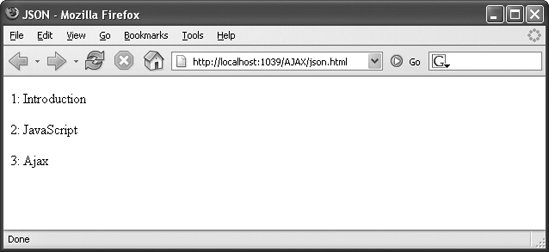Section 3.3. JSON
3.3. JSONA third major technology often used for Ajax applications is JavaScript Object Notation (JSON, http://www.json.org). With JSON, JavaScript objects or data can be persisted (serialized) in a short and easily understandable way, without requiring a lot of JavaScript code to either write or read the data. JSON makes use of an often-overlooked feature of JavaScript, or to be exact of the ECMAScript language specification, also known as ECMA-262. JSON is used internally by current versions of Atlas and generally can be used to exchange complex data with a server. This allows JavaScript to understand it, also the sometimes cumbersome XML parsing with JavaScript can be avoided. The following code uses JSON to define a book object. {"book": { "title": "Programming Atlas", "author": "Christian Wenz", "chapters": { "chapter": [ {"number": "1", "title": "Introduction"}, {"number": "2", "title": "JavaScript"}, {"number": "3", "title": "Ajax"} ] } }} This is the same data that you saw defined using XML in Chapter 2. The object with the book property contains title, author, and chapters properties. The chapters property contains several chapter subelements, each with a number and a title property. This can be best visualized when looking at it as XML data. You will remember it as the exact same XML that was used in the previous section, "The XMLDocument Object," as shown in this code: <book title="Programming Atlas" author="Christian Wenz"> <chapters> <chapter number="1" title="Introduction" /> <chapter number="2" title="JavaScript" /> <chapter number="3" title="Ajax" /> </chapters> </book> The main benefit of JSON is that JavaScript can evaluate the JSON notation without your having to write any code to parse it, as demonstrated in Example 3-3. Example 3-3. Using JSON to easily create objects
Figure 3-7 shows the result of running this script. Figure 3-7. The result of evaluating the JSON notation As you can see in Figure 3-7, the data from the JSON notationthe names of the three chaptersis printed out in the browser. The curly braces that appear in Example 3-3 are used to specify object properties, and square brackets are used for to define array lists. However you will also note something that looks very dangerous from a security point of view. The following line of code evaluates the JSON code at runtime: eval("var obj = " + json + ";");
This line of code uses the built-in eval() JavaScript function, which dynamically evaluates code at runtime. Some programmers consider runtime evaluation bad style, but there is an even worse problem here, namely, eval() implicitly trusts the code it is running. In the example, the JSON notation is part of the script, so you can trust it. In Ajax applications, usually the JSON data comes from the same server as the client page. The trust implicit in the eval() function may be misplaced, especially when you do not control the page the JSON object comes from or when the machine that the script runs on has been misconfigured (for instance, by spyware that redirects requests from one server to another). Therefore, be careful when using eval(); only use it on code you can really trust. |